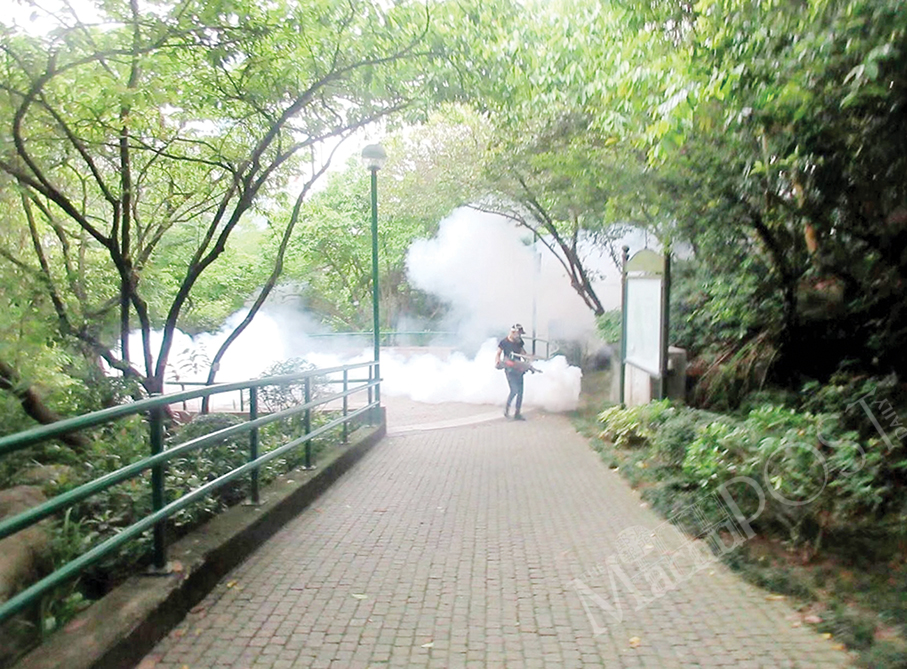The Municipal Affairs Bureau (IAM) and Health Bureau (SSM) said in a joint statement yesterday that hygiene in public parks has been reinforced, urging residents to help eliminate mosquitoes by paying close attention to sanitation and cleaning stagnant water from flower pots and other places where water has accumulated.
The statement pointed out that two cases of the Tsutsugamushi Disease – aka scrub typhus – have recently been discovered in Macau, and it is suspected that both patients had visited the same place – Mong-Ha Hill Municipal Park (望廈山).
According to the statement, the Municipal Affairs Bureau is paying close attention to the issue and sent staff immediately to the Mong Ha Hill Municipal Park, together with SSM staff, to investigate. However, no poor environmental sanitation or a rodent problem were found in the park, the statement underlined.
According to the statement, the Municipal Affairs Bureau has followed the Health Bureau’s guidelines to reinforce the park’s weeding and sanitation work in the park. The statement added that IAM staff increased the amount of pesticides sprayed in the surrounding area on Monday to prevent the breeding of mosquitoes and urged residents to use public facilities correctly while avoiding walking into the grasslands.
In addition, the statement underlined, the Municipal Affairs Bureau had completed its regular lawn mowing and weed removal work before the two cases occurred. The statement underlined that in order to prevent the breeding of mosquitoes, IAM staff conduct mosquito control work twice a month from March to November, and regularly remove any stagnant water that is in the city’s parks at 173 public facilities, such as cemeteries and markets.
The first Tsutsugamushi Disease case was announced by the Health Bureau on Wednesday last week. The patient is a 67-year-old local woman undergoing treatment at the private Kiang Wu Hospital. According to an SSM statement last Wednesday, the woman was in critical condition at that time. The second case reported yesterday is a 61-year-old local woman who suffered fatigue and muscle pain on May 4 and went to Kiang Wu Hospital on May 10 when she came down with a fever. During the diagnosis, a bean-sized eschar was found on her right buttock, but her temperature went down after the treatment. The Health Bureau underlined that the first patient exercised every day on Mong Ha Hill before coming down with scrub typhus, while the second patient works as a cleaner on Mong-Ha Hill.
Meanwhile, the statement pointed out that as mites and rodents are one of the main sources of the Tsutsugamushi Disease, the Municipal Affairs Bureau carries out an annual rodent eradication drive in each district and continues to monitor and control the situation in the streets. The bureau urged residents to pay close attention to environmental hygiene and to remove water that has collected in pots and other receptacles so as to prevent diseases caused by mosquitoes, mites and rodents. The statement added that some discarded food was found in the residential area near the park.
The statement noted that as mites are one of the arachnids that like to hide in grasslands and animal bodies. The Municipal Affairs Bureau urged outdoor enthusiasts to be aware of personal prevention and to lower the risk of being bitten by mites by wearing long-sleeved clothing, putting on insect repellent with DEET, avoiding walking on grasslands and not touching plants, insects and similar animals.
According to the US Centres for Disease Control and Prevention (CDC) website, the Tsutsugamushi Disease is caused by a bacteria called Orientia tsutsugamushi through the bite of infected chiggers (larval mites), symptoms include fever and chills, headache, body aches and muscle pain, and an eschar on the skin.
According to Wikipedia, an eschar is a slough or piece of dead tissue that is cast off from the surface of the skin, particularly after a burn injury, but also seen in gangrene, ulcers, fungal infections, necrotizing spider bite wounds, tick bites associated with spotted fevers, and exposure to cutaneous anthrax.

This undated handout picture provided by the Municipal Affairs Bureau (IAM) yesterday shows a worker spraying pesticide in a public park.








